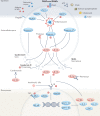IL-1 and autoinflammatory disease: biology, pathogenesis and therapeutic targeting
- PMID: 35729334
- PMCID: PMC9210802
- DOI: 10.1038/s41584-022-00797-1
IL-1 and autoinflammatory disease: biology, pathogenesis and therapeutic targeting
Erratum in
-
Publisher Correction: IL-1 and autoinflammatory disease: biology, pathogenesis and therapeutic targeting.Nat Rev Rheumatol. 2024 Jul;20(7):452. doi: 10.1038/s41584-024-01128-2. Nat Rev Rheumatol. 2024. PMID: 38783116 Free PMC article. No abstract available.
Abstract
Over 20 years ago, it was first proposed that autoinflammation underpins a handful of rare monogenic disorders characterized by recurrent fever and systemic inflammation. The subsequent identification of novel, causative genes directly led to a better understanding of how the innate immune system is regulated under normal conditions, as well as its dysregulation associated with pathogenic mutations. Early on, IL-1 emerged as a central mediator for these diseases, based on data derived from patient cells, mutant mouse models and definitive clinical responses to IL-1 targeted therapy. Since that time, our understanding of the mechanisms of autoinflammation has expanded beyond IL-1 to additional innate immune processes. However, the number and complexity of IL-1-mediated autoinflammatory diseases has also multiplied to include additional monogenic syndromes with expanded genotypes and phenotypes, as well as more common polygenic disorders seen frequently by the practising clinician. In order to increase physician awareness and update rheumatologists who are likely to encounter these patients, this review discusses the general pathophysiological concepts of IL-1-mediated autoinflammation, the epidemiological and clinical features of specific diseases, diagnostic challenges and approaches, and current and future perspectives for therapy.
© 2022. Springer Nature Limited.
Conflict of interest statement
L.B. is a site PI for Novartis, Inc. H.M.H. is a consultant for Novartis and Kiniksa, H.M.H. has research collaborations with Regeneron, Inc.; Jecure, Inc., Zomagen, Inc., Takeda.
Figures



References
Publication types
MeSH terms
Substances
Grants and funding
LinkOut - more resources
Full Text Sources
Other Literature Sources

